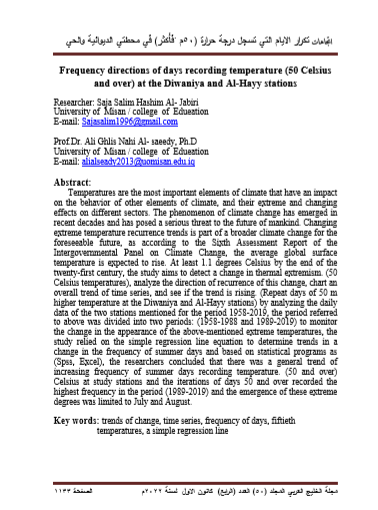Frequency directions of days recording temperature (50 Celsius and over) at the Diwaniya and Al-Hayy stations
Keywords:
trends of change, time series, frequency of days, fiftieth temperatures, a simple regression lineAbstract
Temperatures are the most important elements of climate that have an impact on the behavior of other elements of climate, and their extreme and changing effects on different sectors. The phenomenon of climate change has emerged in recent decades and has posed a serious threat to the future of mankind. Changing extreme temperature recurrence trends is part of a broader climate change for the foreseeable future, as according to the Sixth Assessment Report of the Intergovernmental Panel on Climate Change, the average global surface temperature is expected to rise. At least 1.1 degrees Celsius by the end of the twenty-first century, the study aims to detect a change in thermal extremism. (50 Celsius temperatures), analyze the direction of recurrence of this change, chart an overall trend of time series, and see if the trend is rising. (Repeat days of 50 m higher temperature at the Diwaniya and Al-Hayy stations) by analyzing the daily data of the two stations mentioned for the period 1958-2019, the period referred to above was divided into two periods: (1958-1988 and 1989-2019) to monitor the change in the appearance of the above-mentioned extreme temperatures, the study relied on the simple regression line equation to determine trends in a change in the frequency of summer days and based on statistical programs as (Spss, Excel), the researchers concluded that there was a general trend of increasing frequency of summer days recording temperature. (50 and over) Celsius at study stations and the iterations of days 50 and over recorded the highest frequency in the period (1989-2019) and the emergence of these extreme degrees was limited to July and August.




